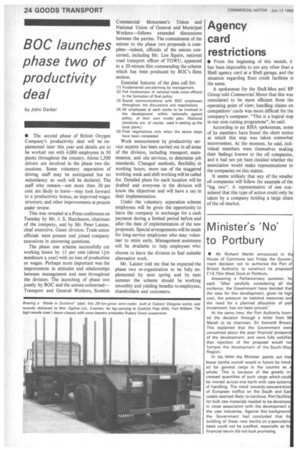BOG launches phase two of productivity deal
Page 26

If you've noticed an error in this article please click here to report it so we can fix it.
by John Darker • The second phase of British Oxygen Company's productivity deal will be implemented later this year and details are to be worked out with 4,000 employees in 50 plants throughout the country. About 1,500 drivers are involved in the phase two discussions. Some voluntary separation of driving staff may be anticipated but no redundancy as such will be declared. The staff who remain—not more than 20 per cent are likely to leave—may look forward to a productivity bonus, an improved wages structure, and other improvements at present under review.
This was revealed at a Press conference on Tuesday by Mr. J. S. Hutcheson, chairman of the company, and by Mr. Peter Laister, chief executive, Gases division. Trade union officials were present and joined company executives in answering questions.
The phase one scheme successfully cut working hours by 15 per cent (about 1 fna manhottrs a year) with no loss of production or wages. Perhaps more important was the improvement in attitudes and relationships between management and men throughout the division. The launching of phase two jointly by BOC and the unions concerned— Transport and General Workers, Scottish Commercial Motormen's Union and National Union of General and Municipal Workers—follows extended discussions between the parties. The commitment of the unions to the phase two proposals is com plete—indeed, officials of the unions concerned, including Mr. Len Squire, national road transport officer of TGWU, appeared in a 20-minute film commending the scheme which has been produced by BOC's films section.
Essential features of the plan call for: 11) Fundamental pre-planning by management.
(2) Full involvement of national trade union officers in the formation of final policy.
(3) Sound communications with BOC employees throughout the discussions and negotiations.
(4) All employees at each worts to be involved in the development, within nationally agreed policy, of their own model plan, (National standards are, of course, used in setting up the local plans.) (5) Final negotiations only when the above steps have been completed.
Work measurement by productivity service experts has been carried out in all areas of the division, including transport, maintenance, and site services, to determine job standards. Changed methods, flexibility in working hours, more use of the staggered working week and shift working will be called for. Detailed plans for each location will be drafted and everyone in• the division will know the objectives and will have a say in their implementation.
Under the voluntary separation scheme employees will be given the opportunity to leave the company in exchange for a cash payment during a limited period before and after the date of implementation of the new proposals. Special arrangements will be made for long-service employees who may volunteer to retire early. Management assistance will be available to help employees who choose to leave the division to find suitable alternative work.
Mr. Laister told me that he expected the phase two re-organization to be fully implemented by next spring and by next summer the scheme should be working smoothly and yielding benefits to employees, shareholders and customers.












































































































